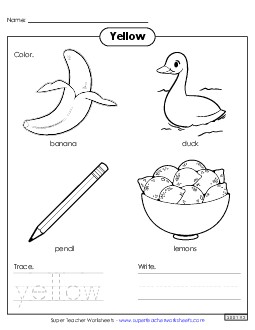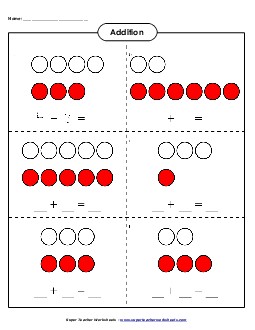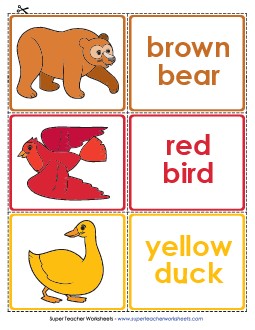Preschool and Kindergarten Worksheets

Write and color on these simple worksheets for each letter of the alphabet. We have different free worksheets for letter recognition, writing/tracing letters, and phonemic awareness.
Awards for PreK and KAward these certificates to your kindergarten students for counting to 100, reciting their ABCs, tying their shows, losing a tooth, and reciting a parent's phone number. Many are free for all to use!
Basic AdditionPractice adding basic facts with addends up to 5 or 10. There are ten-frame addition worksheets, matching games, graphical worksheets, and basic fact drills.
ColorsLearn to recognize, read, and write color words.
Color-By-NumberColor the worksheets according to the simple number-code key.
Comparing Numbers (1-Digit)Count and compare numbers. (example: Circle the block with the greater number of ladybugs.)
Counting and Numbers (Up to 10)Trace, print, count worksheets for specific numbers 1, 2, 3, 4, 5, 6, 7, 8, 9, 10 and 0. Also has worksheets for "counting to 10." Ten-frame worksheets and mini-books.
Counting and Numbers (Up To 20)This page has worksheets with trace, print, count numbers 11 through 20. Also find activities for counting up to 20.
Counting and Numbers (Up to 30)On this page, you'll find trace, print, and count worksheets for specific numbers 21, 22, 23, 24, 25, 26, 27, 28, 29. Also "counting up to 30" as well as dot-to-dot puzzles.
Crowns with Letters & NumbersCelebrate your "Letter of the Day" with these fun alphabet crowns. We have a hat for each letter A through Z, as well as numbers 0 through 10.
Cut, Color & Glue CraftsSimple and free craft projects that students can cut, color, and glue in the classroom or at home.
Dot-to-DotsConnect the dots to make terrific pictures. Learn basic counting skills, skip counting, and the alphabet.
Farm WorksheetsLearn all about farms and farm animals with these fun themed worksheets and activities.
Hundreds ChartPrintable hundreds charts for teaching counting and adding.
Measurement (Non-Standard Units)Measure items using non-standard units. (example: How many blocks long is the paint brush.) Also includes worksheets for using size-comparison words, such as smallest, largest, tallest, shortest.
Mini-BooksHave your youngest students read these basic phonics mini-books.
Picture PatternsTell what shape comes next in each pattern.
Poems and PoetryEasy to read phonic poems for kindergarten students.
Printing LettersLearn to print each letter of the alphabet with these handwriting worksheets.
Phonics WorksheetsTeach your students to read beginning consonant sounds and vowel sounds.
Phonics: Consonant BlendsThis section of our site has hundreds of phonics printables for teaching two- and three-letter consonant blends.
Phonics Word WheelsStudents spin the phonics wheels and read the words.
Right and LeftTeach students the difference between right and left with these printables.
Rhyming WorksheetsWorksheets for Rhyming words, matching, webs, and mini-books.
Scissors - Cutting SkillsDevelop fine motor skills with these activities. Practice cutting along zigzagged lines, straight lines, and curvy lines.
Sentences (Basic Building Sentences)Students build their own sentences with these cut-and-glue activities. On each worksheet, students cut out the words and rearrange them to make a complete sentence.
Shapes: Flat Shapes (Very Basic)Teach young students about triangles, rectangles, squares, trapezoids, and circles.
Shapes: Solid Shapes (Very Basic)This page includes very basic solid shape recognition. Shapes include rectangular prism, cube, cone, sphere, and cylinder.
Sight Word UnitsSTW has a full sight word curriculum with 30 units. Each unit contains a take-home word list, several worksheets, reading practice resources, and assessment materials.
Sight Words (Individual Words)Here are worksheets for over 150 individual sight words. Just choose the word you're working on (example: the, said, these, that) and we'll pull up several worksheets on that specific word.
Sight Words (Dolch Words)Learn basic Dolch sight words with these word wheels, flashcards, and worksheets.
Sight Words (Fry Words)Help your students learn the Fry Instant Sight words with these word wheels, checklists, and printables.
Skip Counting by 2sTeach your students to skip count by 2s.
Skip Counting by 5sTeach your students to skip count by 5s.
Skip Counting by 10sTeach your students to skip count by 10s.
Spatial RelationshipsLearn about basic spatial relationships. (examples: The dog is below the tree. The cat is next to the house. The pig is under the blanket.)
Word FamiliesWe have worksheets for dozens of different word families, including -ack, -ad, -ake, -am, -an, -ay, -eat, -ell, -in, -it, -ook, -ot, -ump, -unk, and more.
Brown Bear, Brown Bear, What Do You See?This page has printable worksheets that can be used with the book, Brown Bear, Brown Bear, What Do You See? by Bill Martin Jr. and Eric Carle. Includes coloring pages, cut-and-glue worksheets, and games.
If You Give a Mouse a CookieHere is a full unit of worksheets to go along with the book, If You Give a Mouse a Cookie, by Laura Numeroff.
Polar Bear, Polar Bear, What Do You Hear?The activities in this picture book literacy unit go along with the book, Polar Bear, Polar Bear, What Do You Hear?
Theme PrintablesThemes include zoo animals, farms, sea life, apples, and others.
First Grade Reading ComprehensionThese reading passages are specially designed for first graders, but some younger kids might be able to use them as well.
First Grade SpellingThese spelling words can compliment an early-reading program.



Kindergarten curricula are all about establishing the foundational skills that students will continue to develop throughout the rest of their educational journey. Math and reading are always foregrounded as core subjects and receive the most extensive instruction. In math, kindergarteners focus on basic concepts such as recognizing and writing numerals, counting (by ones, twos, fives, etc.), single-digit addition and subtraction, identifying shapes, and understanding patterns. In English Language Arts (ELA), the emphasis is on letter recognition, phonics, learning sight words and decoding simple words, and identifying basic components of sentences and stories. Phonics is particularly important. Teachers introduce it through fun activities, songs, and stories that help students recognize letter sounds and blend them together. Frequent listening, speaking, guided reading, and writing practice is key for developing kindergarteners’ early literacy skills.
Kindergarten also acts as the introduction for other subjects like science and social studies. Kindergarten science lessons often revolve around children exploring the world around them. Topics such as the weather, the life cycles of plants and animals, and the five senses allow students to engage in high-interest, hands-on learning and observation. For social studies, kindergarteners usually focus on understanding the basics of family roles, community, and recognizing important figures in society, such as community helpers. Social skills are also an important focus, as children learn how to share, cooperate, follow rules, resolve conflict, and express emotions appropriately. These early social skills are vital for creating a positive classroom environment and building a foundation for future social interactions.
Hands-on activities, play-based learning, and visual aids are especially important methods for teaching kindergarteners effectively. Developmentally appropriate lessons should be short and interactive to complement young learners’ attention spans and energy. Activities like counting games, letter tracing, simple science experiments, and story time help make learning enjoyable. Learning centers—where students rotate between different stations, such as sorting and counting math manipulatives, sight word practice, and art projects—are a common approach to keep students actively engaged. Super Teacher Worksheets offers printable kindergarten worksheets and tools in all of these areas to help early learners!






